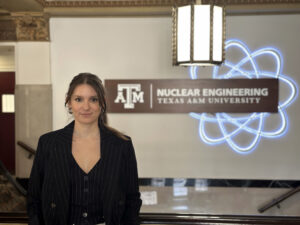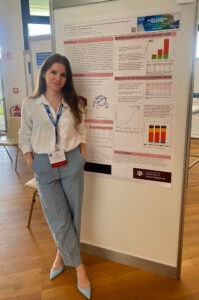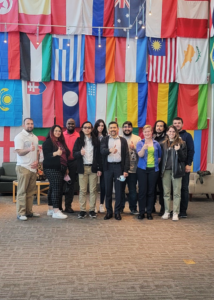Nuclear energy is gaining greater appeal because it is considered a low CO2 emission power source. Nevertheless, the establishment of a sustainable and robust nuclear program involves addressing several challenges, including the management of used nuclear fuel and controlling proliferation risk. One solution to the used fuel challenge is reprocessing; however, the accumulation of secondary nuclear materials, including plutonium, minor actinides, and reprocessed uranium, during the reprocessing of used nuclear fuel poses a potential risk in terms of nuclear proliferation.

The proliferation resistance of a nuclear material refers to how difficult it would be to employ that material in the development of a nuclear weapon given its inherent characteristics. According to Melis Yildiz Sakarya, a graduate student working with Center for Nuclear Security Science and Policy Initiatives (NSSPI) Director Dr. Sunil Chirayath, these characteristics can be combined with external measures to hinder the development of nuclear weapons. In her research, Yildiz Sakarya investigated the feasibility of protected plutonium production (PPP) by assessing the proliferation resistance of multi-recycled enriched reprocessed uranium from the Vodo-Vodyanoi Enyergeticheskiy Reactor (VVER-1000), a Russian-designed Light Water Reactor that is widely used throughout the world.
“The International Atomic Energy Agency (IAEA) has said that plutonium containing more than 80% of the Plutonium-238 isotope can be exempted from safeguards. This is the only official criterion with respect to the isotopic barrier of plutonium. The question is, would a Plutonium-238 content significantly lower than 80% be sufficient to denature plutonium to be used in nuclear explosive devices?”
“Denaturing” refers to the process of rendering the plutonium unsuitable for military use. Yildiz Sakarya explained, “Plutonium-238 plays a vital role in denaturing plutonium due to its high spontaneous fission and heat generation rate, and, depending on the enrichment of the nuclear fuel, the multiple recycling of nuclear spent fuel enables Plutonium-238 to increase up to 6-8%.”
Yildiz Sakarya performed fuel burnup simulations by modeling a VVER-1000 fuel assembly employing the Monte Carlo radiation transport code (MCNP). She then estimated the growth in the desired amount of Uranium-236 and Plutonium-238 isotopes. To simulate the re-enrichment of the reprocessed uranium, she used the Matched Abundance Cascade Ratio (MARC) model developed for multi-component systems.
“Our study found that only 2 times of recycling of spent nuclear fuel enabled the Plutonium-238 content to increase to 8%,” she stated, “which is effective enough to prevent the spent nuclear fuel from being used for nonpeaceful purposes.”

Furthermore, she indicated that recycling reprocessed uranium would not only enhance the proliferation resistance of spent nuclear fuel but would also reduce the demand for uranium resources in the future due to its great capacity for producing energy. Making reprocessing less risky from a nuclear proliferation perspective is key to unlocking the potential of used nuclear fuel.
Yildiz Sakarya will graduate from Texas A&M University in December 2023 with an M.S. in nuclear engineering with a nuclear nonproliferation specialization. Throughout her academic journey, she had the privilege of collaborating on her research with Dr. Masaki Saito, an expert in the area who is professor emeritus, former department head of the Department of Nuclear Engineering, and former Director of the Academy for Global Nuclear Safety and Security at the Tokyo Institute of Technology in Japan. She visited numerous national labs and IAEA facilities, where she had the opportunity to meet with prominent figures in the nuclear field. During her time at NSSPI, she was able to present her master’s research at the 2023 Institute of Nuclear Materials Management (INMM) / European Safeguards Research and Development Association (ESARDA) Joint Annual Meeting in Vienna, Austria, and the 2023 Department of Nuclear Engineering Advisory Council Spring Dinner at Texas A&M, where both of her posters were selected as student award winners. In recognition of her achievements, Yildiz Sakarya was nominated for the 2023 College of Engineering Outstanding Graduate Student Award.

“My academic experience at Texas A&M exceeded all my expectations,” declared Yildiz Sakarya. “During my time here, I had the extraordinary opportunity to meet and learn from distinguished experts in the field of nuclear engineering. I had the privilege of engaging with renowned professors such as Dr. Siegfried Hecker, Dr. Masaki Saito, and Dr. Frank Von Hippel, whose expertise and insights enriched my academic journey. These encounters not only broadened my knowledge but also allowed me to forge valuable connections and gain profound insights into the complexities of nuclear research and nonproliferation. My time at Texas A&M has been a transformative educational experience that has deepened my passion for my field and opened doors to a wealth of knowledge and collaboration.”
Before joining NSSPI, Yildiz Sakarya graduated from Hacettepe University in Turkiye with a B.S. in Nuclear Energy Engineering and was awarded a scholarship from the Turkish Government to study abroad. After graduating, she will continue to pursue her Ph.D. in nuclear engineering.